early firearms: artillery
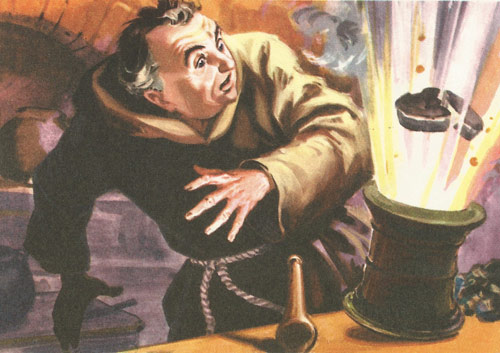
Figure 1. An early gunpowder explosion.
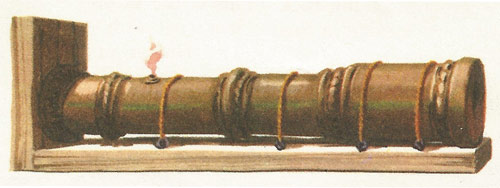
Figure 2. In the early part of the 14th century men began to use a tube instead of a bucket. These were the first real 'cannons'. They were usually made of bronze or brass, but occasionally iron was used. There were three chief kinds: small guns, which weighed from 12 to 20 pounds; medium-weight guns weighing from 30 to 55 pounds; large guns between 100 and 300 pounds. These guns were all muzzle loading. They exploded when a fuse burned through a hole in the breach.
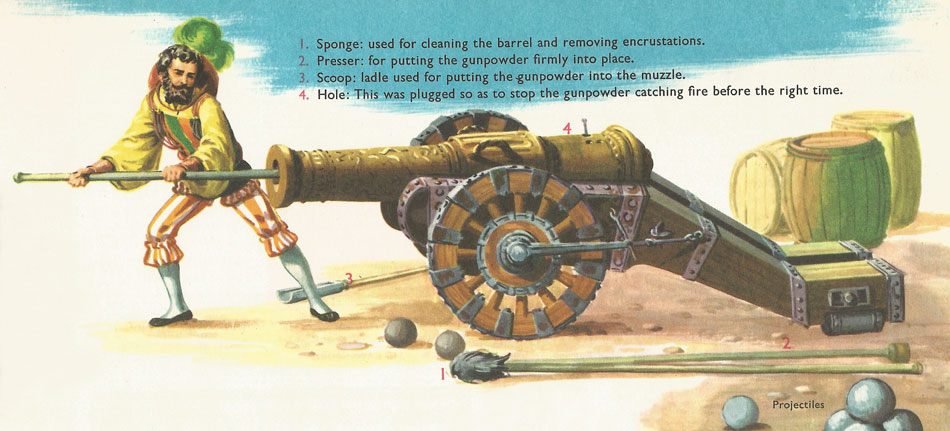
Figure 3. Loading an early cannon.
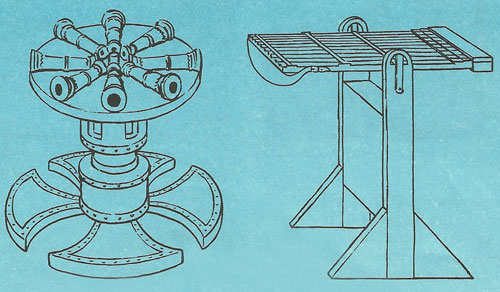
Figure 4. Early multiple-barreled guns. Left: one of the first 'machine guns' (from a wood engraving of 1483). Right: This type of 8-barreled gun was built at the beginning of the fifteenth century and was a good deal safer to use. The French called it an 'orgue' as the arrangement of the barrels reminded them of an organ.
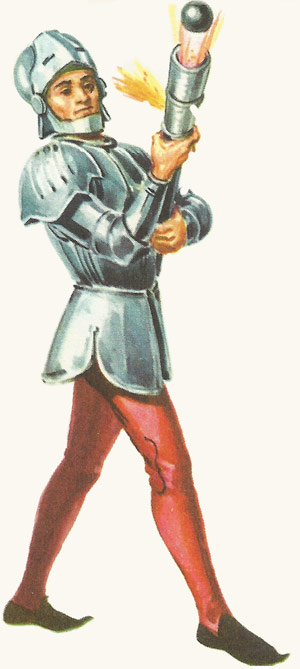
Figure 5. Hand gunner in the 15th century.
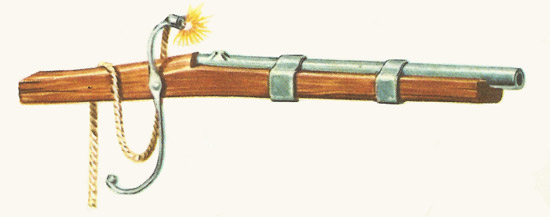
Figure 6. An arquebus.
Exactly when gunpowder was invented we do not know. There is certainly no truth in the old story that it was the work of a German monk who mixed together saltpeter, charcoal, and sulfur to make an explosive mixture (Figure 1). Gunpowder was in use before this monk lived. He worked in the fifteenth century, but men were using firearms long before 1400.
It may have been the Arabs or Chinese who invented it. As early as the thirteenth century alchemists, searching for some way of turning metals to gold, had had surprising results when they pounded these three substances together in a mortar. Spark flew, and sometimes there was an explosion so strong that the pestle flew out of their hands. It didn't take long for them to try sending projectiles through the air by deliberately making this explosion. They began with pebbles, and these jumped yards into the air before landing.
Early cannons
The next step was to build containers for these explosions. The first time they were used in warfare was probably in 1275, when the Arabs were defending Granada, in Spain.
These first 'cannons' were very primitive. They merely consisted of large iron buckets with a hole in the bottom.
Some 2 pounds of gunpowder and a dozen small stones were placed in the bucket and a lighted fuse was put through the hole. The stones shot into the air with a colossal noise, but it was the noise that was the most terrifying part of it, for it was almost impossible to aim the projectiles. The cannons were nearly as dangerous to those firing them as to the enemy. Their effect was greatest on the minds of the enemy. The various bows in use were still the most accurate weapons.
But gradually these guns improved. They were used by both sides in the Hundred Years War between England and France, and though the English won most of the earlier battles by their superb long-bows, the French beat the English at the Battle of Castillon in 1453 largely through the power of their guns.
The cannon were cumbersome and dangerous but the days of the bow were numbered.
Evolution of the cannon
By 1500 the new weapons, which were called 'cannons', were being made in a form which was to vary very little for many centuries. To make it easier to move, the barrel was mounted on two large wheels (Figure 3). When stationary it could be balanced on a pivot so that it could be aimed – or 'laid' – quickly. To load the cannon, the gunner would push the gunpowder down the muzzle, using a long stick for the purpose. He would press it hard against the breech. Next he would slide in a wooden disk to keep the gunpowder separate from the cannonball. The ball itself went in last of all.
The whole operation was very dangerous. The gunpowder itself, when being transported, would send up a whole cloud of dust that a spark would explode at once. Someone then thought of taking the three ingredients of gunpowder along separately and mixing them together in a trough as they were needed. But this was complicated, and it was eventually found easier – and safer – to prepare the gunpowder in small quantities which were bound together with spirit or water and left to dry. This formed slabs which could be ground down to make the quantities required for loading.
Until about 1420, the projectiles were simply stones, shaped to a rough sphere. But later iron and lead were used, and these had grooves, or 'rifling', cut into them to make them more accurate. But this type of cannon still took a long time to load, and the gunner was exposed to enemy fire the whole time.
Breech-loading guns
The first breech-loading gun was built about 1380, and its purpose was to let the gunner reload without coming into the open. At the back of the gun a foot-long section of the upper part of the barrel was sawn off so that a movable breech could be fitted on. Into this breech were placed the gunpowder and ball. It was then closed tight. Loading could thus be carried out at the back, and the gunner could remain in shelter.
The breech was never a very close fit; consequently the gases caused by the explosion escaped through the join and the muzzle velocity was much reduced.
So muzzle loading went on, and it was not until the 19th century that the breech loaders were good enough to displace the muzzle-loaders for good.
The first multiple-barreled guns
When it was clear that the new weapon was effective, the next thing was to make it fire more quickly. The gun shown in Figure 4 was made about 1360 and is the ancestor of the machine-gun. The eight barrels were loaded with gunpowder and cannon balls. Each was pointed at the enemy and fired in turn. But sometimes, by mistake, all the barrels went off at once – with results that can be imagined! There were few volunteers to work this type of gun.
Hand-held cannon
Small potable weapon developed at the same time as heavier guns. Figure 5, which is based on an old engraving, shows a 'hand-gunner' of the 15th century. The weapon that he is handling is really a miniature cannon. These guns had none of the mechanical devices of our modern guns; they simply consisted of a tube fastened to a wooden handle. To fire his shot, the soldier first loaded the weapon and then ignited the gunpowder by putting a piece of lighted string in the hole in the barrel.
The arquebus
The arquebusis much nearer to the modern gun (Figure 6). The wooden butt enables the weapon to be placed to the shoulder. There is also a trigger, in the shape of a large S. The lighted fuse is at the end of the trigger, and the soldier could set off the powder by simply moving his finger.
The arquebus, however, like all the early fire-arms, had two great disadvantages. It was highly dangerous to the user. And it was very inaccurate.
